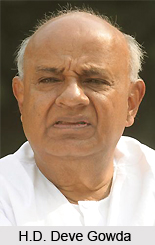 Janata Dal (Secular) is the Indian political party considered the `left of centre`. The party was led by former Prime Minister of India H.D. Deve Gowda. The Janata Dal (Secular) was established in July 1999, after a split in the party. JD(S) is very active politically in Karnataka. The party has its roots in the Janata Party organised by Jayprakash Narayan, which was formed under one banner and united all anti-Indira Gandhi parties for the 1977 national elections.
Janata Dal (Secular) is the Indian political party considered the `left of centre`. The party was led by former Prime Minister of India H.D. Deve Gowda. The Janata Dal (Secular) was established in July 1999, after a split in the party. JD(S) is very active politically in Karnataka. The party has its roots in the Janata Party organised by Jayprakash Narayan, which was formed under one banner and united all anti-Indira Gandhi parties for the 1977 national elections.
The Janata Party split twice- first in 1979 and then again in 1980. It gave birth to the Bharatiya Janata Party that consisted members of the former Jan Sangh. It was close to the Rashtriya Swayamsevak Sangh. In 1988, the Janata Dal was formed by unification with the Janata Party; the merger took place in Bangalore. In 1999, Janata Dal again separated after H.D. Deve Gowda became the Prime Minister of India as part of a coailition (called United Front) government in 1996. After its split, JD(S) emerged under the leadership of H.D. Deve Gowda. Another faction of the Janata Dal rose out from the split which came to be known as the Janata Dal (United) party, led by George Fernandes.
H.D. Deve Gowda has always tried to maintain equi-distance from both the Bharatiya Janata Party and the Congress. Deve Gowda is a member of Lok Sabha for the Hassan district in Karnataka. Janata Dal (secular) is considered the third-largest in the Karnataka state legislature. The party has also governed in a coalition with the Indian National Congress (INC), the first coalition government in Karnataka. Janata Dal once again disunited between its two leaders as JDS(Siddaramaiah) group and DeveGowda group. In the recent past Deve Gowda group had conjoined hands with BJP, and together now govern Karnataka.




















